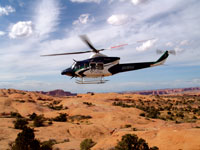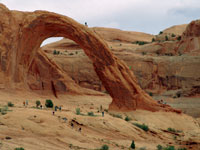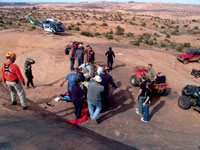TRAIL HAPPENINGS March 2012
Trail Safety in Grand County
by Trail Mix
 Carefully planned and maintained trails help keep visitors safe in Grand County, which has the dubious distinction of requiring the most rescues of any county in Utah. Thousands of visitors and locals enjoy a variety of sports in the backcountry around Moab, but those sports present risks, and Grand County covers a vast area. Arches and Canyonlands National Parks as well as Dead Horse Point State Park have many rescues as well. Carefully planned and maintained trails help keep visitors safe in Grand County, which has the dubious distinction of requiring the most rescues of any county in Utah. Thousands of visitors and locals enjoy a variety of sports in the backcountry around Moab, but those sports present risks, and Grand County covers a vast area. Arches and Canyonlands National Parks as well as Dead Horse Point State Park have many rescues as well.
In addition to the Moab backcountry’s complex system of roads, trails, washes, canyons, cliffs, rivers, and mountains, trails and waypoints can have many names and nicknames. The Grand County Non-motorized Trail Mix Committee has also recently added many new mountain bike trails to the Moab area. The group keeps Grand County updated with the most current trail maps at http://www.grandcountyutah.net/trailmix/Maps.htm
Lost or injured in the Moab area? Even the most experienced outdoors individuals following well-marked trails can have accidents. You will hopefully be able to connect by 911 to emergency personnel. However, being prepared is your responsibility, and preparation could save your life or the life of someone else.

The most serious injuries are often in ATV, motorcycle, and mountain bike accidents, including road rash, broken bones, and scraped up legs, arms, and faces. The usual causes are loss of control and lack of skills, though helmets and proper body and footgear can keep an accident from becoming a fatality. Fortunately, there was only one ATV fatality in 2011.
Every river rafter, kayaker, swimmer, and floater needs a life vest. Wearing a life vest on the Colorado River is required by law. There were two river fatalities in 2011, perhaps partly due to it being a very high water year on the Colorado. Among hikers, rock climbers, BASE jumpers, and Jeepers, there were some incidents in 2011—most of them avoidable—but no fatalities. Hikers sometimes got caught after dark, didn’t know the trails, or did not have a map, light, or compass. Trail safety can include wearing proper hiking footwear, following cairns and obeying signs, and packing a headlamp and appropriate trail and topographic maps. Climbers, jumpers, slackliners, and Jeepers should  have training, proper gear, and repair and first aid kits for emergency situations. have training, proper gear, and repair and first aid kits for emergency situations.
Travel with a friend who can go for help or assist the injured person. If you are the one going for help, note the injured person’s location so you can lead others back to the accident site. Alert someone to where you are going and when you plan to return, including the name of the trail, road segment, site, or area. Bring a map and a GPS (and know how to use it). Pack extra batteries, and carry a cell phone, although many backcountry areas will not have service. It is possible that 911 or texting may still work, and, if there is coverage, many cell phones now report your GPS location.
When a 911 call is initiated, trained rescuers and medical staff are dispatched. On call 24/7 year round, these first responders may have trouble locating an individual if they don’t know where the individual is. Know your trailhead name and location, specific trail name, and nearest road. To expedite a potential rescue, carry a satellite-based SPOT tracking device or GPS.
St Mary’s helicopter services, a 4x4 van or a 4x6 Ranger vehicle may come into use via Moab’s 911 service to transport ill or critically injured individuals. When these options are not available, injured people will be manually transported on a wheeled litter to the closest medical transportation available.
Natural light will help you stay safe, so if you start early and know when sunset is, you won’t get caught trying to follow a trail in low light. Even with a headlamp, hiking in the dark can be challenging. Bring, rent, or buy the proper gear: life vests (including for your dogs), hiking boots and good socks, bike helmets, seat belts, etc. Dress for the weather: layers of light-colored, natural-fiber clothing plus a wide-brimmed hat will help keep you comfortable. Visitors have come to Moab thinking it’s universally hot. Though it is hot in the summer, if you travel into the La Sal Mountains above 11,000 feet, you might encounter storms and nighttime cold weather.
Heat-related incidents and accidents during the summer are common. Don’t underestimate problems created by high temperatures. Match your adventure to your conditioning, and carry and drink plenty of water. Be aware that you can also get dehydrated in cold-weather conditions.
Enjoy a safe and fun experience in the Moab backcountry, but prepare for your adventure. Trained emergency personnel are ready if and when an emergency does happen, but visitors will prefer experiencing the trails and the red rock scenery, not our new hospital’s emergency room.
 Trail Mix This committee represents non motorized trail users including: bikers, hikers, equestrians, and skiers. Many government agencies and private citizens comprise the “mix” that makes this group work so well. We meet the 2nd Tues. of each month from 12-2 at the Grand Center (500W. 182 N.). Everyone is welcome. Trail Mix This committee represents non motorized trail users including: bikers, hikers, equestrians, and skiers. Many government agencies and private citizens comprise the “mix” that makes this group work so well. We meet the 2nd Tues. of each month from 12-2 at the Grand Center (500W. 182 N.). Everyone is welcome.
Contact Sandy Freethey 259-0253 or find us online: wwwgrandcountyutah.net/trailmix/ or at moabtrailmixinfo@gmail.com.
|
|